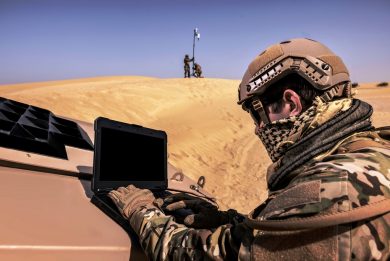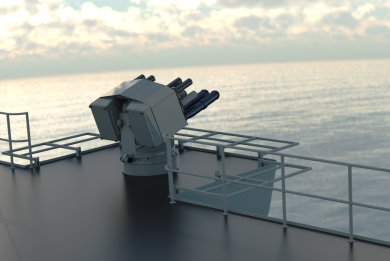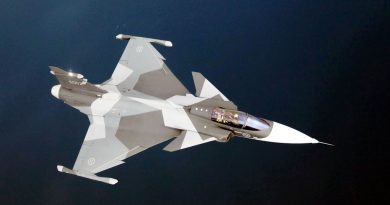
Saab Barracuda: ULCAS goes frequency selective while the company looks at organic fibres for future nets
At DSEI 2023 Saab Barracuda will unveil a new version of its ULCAS camouflage net system, which is frequency selective, allowing VHF/UHF equipment to work perfectly under cover while also transparency to GPS signals will considerably improve. In the mean time the R&D division is working on organic fibres to produce biodegradable netting systems
The rocky-sandy hill allows a perfect view over the target area. As weather forecast tells that in the coming days it will be hard to ensure full day coverage with UAVs, a team was dispatched to survey the area and eventually send target grids back to the command post. Well hidden under their Saab Barracuda ULCAS (Ultra-Lightweight Camouflage Screen) they observe the scene through their targeting binoculars and are ready to relay the grids via their software defined radio, either in standard or SATCOM mode. The ULCAS ensures good multispectral camouflage properties as it works in the visual, near infrared, short wave infrared, thermal infrared and radar spectrum Problem: it is not transparent to radiofrequency! This means that either personnel has to leave the camouflage protection to send out messages or that antennas must protrude from the cover, not a nice perspective in both cases.
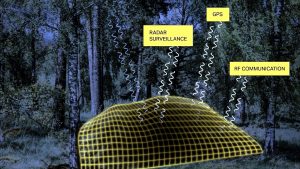
“The ULCAS camouflage net is three dimensional, is multispectral and protects against all sensors that are operating on the battlefield. Actually there is one single drawback with this camouflage; radio waves from communication devices have a hard time penetrating the net, the reason being that we have a broadband radar absorber in the camouflage net,” Johan Jersblad, Ph.D. and senior development engineer at Saab Barracuda explains. A graphic shows radio waves coming with a high angle, the reason being that there is a growing number of radar surveillance satellites, not only governmental but also commercial ones, he explains. The ULCAS is able to cope with those incoming signals in order to avoid them bouncing back towards the originating radar, however it also does not allow GPS and communication signals to go through, and this is the main issue, which is common to all this type of netting.
To cope with this, Saab Barracuda developed a new net, the ULCAS-FSS, the second acronym standing for Frequency Selective Surface, which means that some frequencies can go through while other cannot. No in-depth details on the technology used were revealed, but “in principle, we print our materials with a specific frequency selective surface,” Johan Jersblad said. “This is designed as a low-pass filter, which means that waves with low frequency easily pass the system whereas radar surveillance frequencies are absorbed in the camouflage net,” he underlined, adding that “we can choose which frequency we let in and out of the system.”
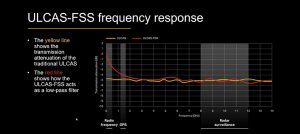
According to a diagram shown during the presentation, attenuation for VHF/UHF frequencies is in the order of 1or 2 dB. As attenuation in dB follows a logarithmic curve, this means that between 80 and 65% of the signal goes through the net allowing using radio equipment under the camouflage cover without the need to let antennas protruding out of the net. The curves behave quite differently as frequencies increase, and for GNSS signals fall between 1.2 and 1.6 GHz attenuation is higher, short of 4 dB. This is slightly lower than attenuation in higher frequencies, and should let GNSS equipment work properly as around 50% of the signal goes through, compared to less than 30% when moving into radar frequency bands.
Problem solved for our targeting team, which can exploit the GPS embedded in the binocular, and communicate target grids via its SDR VHF/SATCOM radio.
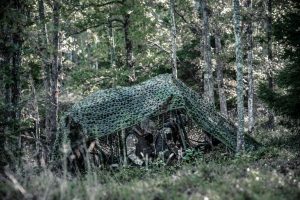
The new ULCAS-FSS will be launched at DSEI 2023 next week, Saab Barracuda starting production in its Swedish facility. “It will be available on multiple markets and depending on production capacity it may very well be that it will then be produced in our partner network,” Henning Robach, Head of Business Unit Barracuda, stated. The company has partners in different countries, such as in Canada with Tulmar Safety Systems ì and in France with Solarmtex, the speaker saying that the next step will be to expand the company production capacity also into the United States.
The ULCAS-FSS is not the only improved camouflage system that Saab Barracuda will exhibit at DSEI. Unveiled at Eurosatory 2022, Barracuda’s Soldier System is a lightweight and square-shaped net that can be used in different ways depending upon mission requirements. One year later, at DSEI 2023, the company will present an improved version of that system.
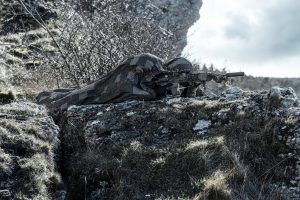
“Our Soldier System is reversible,” Johan Jersblad pointed out, “So you have the night side, which has a better thermal suppression, and you have the day side, which features a visual camouflage as well as the thermal infrared coating. In the improved version we bring to DSEI we have upgraded the IR coating on both sides.” But this is not all. “The Soldier System has also been upgraded in terms of usability. We did a survey and a thorough analysis with some customers on how it is being used,” Henning Robach explained, so the layout was refined moving buttons and pockets in order to make the Soldier System even more user friendly.
Looking further away on the timeline, Saab Barracuda is going green, not in the sense of the camouflage colour but in terms of sustainability. “We have a few different projects that we’re running. One is using recycled polymers for making our camouflage products while the other one is based on plant fibres. The latter was actually born out of a new threat sensor, as we see more and more hyperspectral sensors that can detect manmade materials,” Henning Robach stated. “In the future it will not be enough to just decently follow the spectral signature of nature, you will more or less need to be in the nature,” he explained.
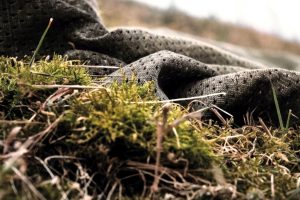
Therefore the Barracuda R&D department started to investigate different solutions, one of them being to use natural fibres with low carbon footprint. “These fibres can be generated out of something we have very much in Sweden, that is forest. So we have secured our supply line,” Johan Jersblad pointed out, adding that “Another benefit with the fibres we’re looking at is that they’re biodegradable, so in principle this means that you can leave your camouflage nets out in the forest and after some time they will degrade, which is really neat thing from a sustainable point of view, not to mention sustainable production processes.”
Commenting on biodegradability, the speakers explained that the R&D department is working on different issues, one of them being the degrading time, which can be measured in over half a year, as well as on storage issues. “A net in a dry and dark warehouse will stay in perfect condition for 10 years, but a net heavily used, folded many times and exposed to moisture would degrad faster,” they explained, saying that a normal life should be around 200 installations.
EDR On-Line understood that prototypes of such fibre-based nets are already available at the Saab Barracuda R&D department, and that beside their signature properties they are being tested to verify they also fulfil the other requirements such as user friendliness, fire resistance, durability, etc. Saab Barracuda experts forecast that they might become a product in two-year time. And that might be a sort of comeback, as in the 1960’s then Barracuda moved away from natural fibres to produce plastic based nets while in the 2020’s the path will be reversed, moving from plastic to organic fibres, but with a wholly different perspective.
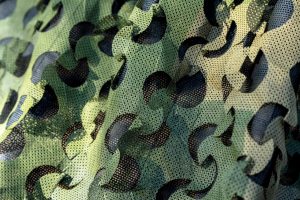
Cutting down waste, using only chemicals that have a very low impact on nature, is one of Saab’s targets. Another project going in that direction is the use of recycled polyester, coming from recycled PET bottles, to produce camouflage nets. “We will have our first prototype based on recycled PET in 2023 and this will then be of course evaluated, so we make sure that it fulfils all our specifications,” Henning Robach unveiled.
Photos and graphics courtesy Saab Barracuda

